| Ford Ka | |
|---|---|
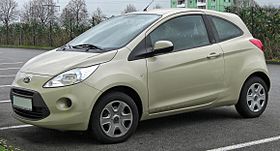 |
|
| Overview | |
| Manufacturer | Ford |
| Production | 1996–present |
| Body and chassis | |
| Class | City car (1996–2016) Subcompact car (2014–present) |
| Layout | Front-engine, front-wheel drive |
The Ford Ka is a small car manufactured by the Ford Motor Company from 1996 to 2016, as a city car, and from 2014 to present as a subcompact car.
It entered its second generation in 2008, being produced by Fiat in Tychy, Poland A third generation was introduced in 2014The first two generations have a three-door hatchback body style, with the first generation also having a two-door convertible version that was marketed as the StreetKA, alongside a sporty hatch version, known as the SportKA. There is also the Ford Ka NOW. The third generation is produced as a five-door hatchback and as a four-door sedan. It was initially available only in Brazil, being later introduced in India, Mexico, South Africa (where it is marketed as the Ford Figo), Argentina and Europe.
Pronunciation
The name Ka has a number of possible pronunciations. For example, with a long or short "a", or with the letters pronounced separately. Ford's press office has used all three. According to Auto Trader, Ford "top brass" have given the correct pronunciation as "'Ka like "Cat".'"
First generation (1996–2008)
| First generation | |
|---|---|
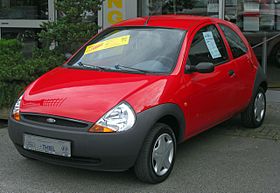 |
|
| Overview | |
| Production | 1996–2008 (Spain) 1997–2013 (Brazil) |
| Assembly | Almussafes, Spain (Valencia Body & Assembly) Sao Bernardo do Campo, Brazil (Ford do Brasil) Turin, Italy (Pininfarina) |
| Designer | Claude Lobo (Ka) Pininfarina (StreetKa) |
| Body and chassis | |
| Body style | 3-door hatchback 2-door convertible 3-door van |
| Powertrain | |
| Engine | 1.3 L Endura E I4 (to 2002) 1.3 L Duratec I4 (from 2002) |
| Transmission | 5 speed manual |
| Dimensions | |
| Wheelbase | 2,452 mm (96.5 in) |
| Length | 3,620 mm (142.5 in) (1996–2008) 3,836 mm (151.0 in) (2008–present) 3,650 mm (143.7 in) (StreetKa) 3,650 mm (143.7 in) (SportKa) |
| Width | 1,631 mm (64.2 in) (1996–2008) 1,812 mm (71.3 in) (2008–present) 1,679 mm (66.1 in) (StreetKa) 1,695 mm (66.7 in) (SportKa) |
| Height | 1,368 mm (53.9 in) (1996–2008) 1,420 mm (55.9 in) (2008–present) 1,409 mm (55.5 in) (StreetKa) 1,409 mm (55.5 in) (SportKa) |
| Curb weight | 820–962 kg (1,808–2,121 lb) |
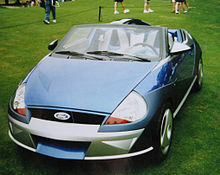


The car was introduced on 11 September 1996 as a small and low-cost addition to the Ford range. It was based on the Mark IV Ford Fiesta platform, but with a completely different exterior design. The design borrowed a lot from Ghia's "Saetta" show car, a roadster designed by Filippo Sapino. The Ka evolved from concept vehicles to production with minor changes. The large, one piece, moulded bumpers and wheel arches made the vehicle more durable and easier to repair. The vehicle was manufactured on the existing Fiesta production line in Almussafes, Valencia, minimising new model investment costs. The Chief Program Engineer was Kevin O’Neill. The designer of the car was Chris Svensson of Sunderland, who had designed a similar-shaped car when at the Royal College of Art in 1992.
When the Ka was introduced to the public it provoked mixed reactions, due to its original and striking New Edge design, overseen by Jack Telnack and executed by Claude Lobo.
Besides the styling, the Ka, like its sister cars Fiesta and Puma, was lauded in the motoring press for its handling. Under Richard Parry-Jones' supervision, the suspension and steering settings allowed for hard cornering and high levels of grip, providing strong handling characteristics.
At launch, Ka was produced as a single model, with a number of production options including air conditioning, power steering, height-adjustable driver’s seat, adjustable position rear seat with head restraints, passenger airbag, central locking and power windows. An anti-lock braking system option was added in January 1997.
Aside from corrosion,[citation needed] the main drawback was the 1,300 cc OHV four-cylinder Endura-E engine, a design dating to the 1950s Kent engine used in the Ford Anglia. Although not very modern, it provided enough torque to allow relaxed if not spirited driving. In 2002, the Endura-E was replaced by the overhead cam Duratec engine, with claims of improved fuel efficiency and increased refinement, mostly caused by taller gearing on the non-air conditioned models.
For the first three years of production, all models had black plastic bumpers to minimise parking damage to paintwork in city conditions. These bumpers contained a stabiliser to prevent UV degradation which made them unsuitable for painting because the paint would not adhere properly. However, it became clear that many owners wanted body-coloured bumpers, so they were introduced in 1999 using different bumper mouldings (without the stabiliser).
The Ka has proved highly profitable for Ford despite its low selling price, largely due to its low development costs. In 2006, Ford sold 17,000 examples of the Ka model in the United Kingdom. As with other Ford models, insufficient anti-corrosion treatment during manufacture and the use of non-galvanised steel results in premature surface and structural corrosion becoming established on cars used in more northern, damp climates.[citation needed]
In Australia, the Ka was introduced in October 1999 and was sold until 2002. It was unsuccessful – fewer than 2,000 were sold per year. This was partly due to the lack of an automatic transmission, which is favoured by a large proportion of Australian car buyers. The Ka was also sold in New Zealand between 1999 and 2004, and was replaced by the newer Fiesta.
United Kingdom

The Ka has been the best selling car in its class in the United Kingdom for a number of years and commands around a fifth of the city car market. The UK model range originally consisted of the base version, the Ka, and the higher specification Ka² which standardised a number of the options listed above. The Ka² badge was fitted by dealers. Ka³ was introduced later. Power steering was added to the specification of the basic Ka after the first year.
Concurrent with the introduction of body-coloured bumpers Ka² and Ka³ were replaced by Ka Collection and the LuxuryKa (later Ka Luxury).
The Luxury version came with a Quickclear heated windscreen, leather seats and interior trim as well as standard air conditioning. A 'Ka Blue' special edition was also launched in the UK with dark blue bumpers and a silvery-blue dashboard insert, rather than the standard models' silver. The Ka Sun Collection with a full-length fabric folding roof was also added to the range during the summer months.
Unique to the UK was the Ford Ka Van variant, produced exclusively for BT Group and featuring a bespoke flat plywood floor with rubber over-mat and white ply covers instead of rear windows.
A further line-up revision gave Ka the following trim levels in the United Kingdom: Studio, Style, Style Climate and Zetec Climate. In 2005 the Sublime model was introduced. This featured special leather interior & features not found on other models. This was only produced in very small numbers and is now one of the most sought after KA's. SportKa was also added to the range (see below). With the car's impending replacement, in May 2008 a Finale special edition with distinguishing features such as roof decal and black wing mirrors was made available.
StreetKa and SportKa



In 2003, the Ka brand was diversified, with the addition of a new SportKa featuring a sporty body kit, wider track with stiffened suspension and redesigned 16" (40 cm) alloy wheels. Both models came with slightly widened bumpers front and rear with integral fog lamps. A convertible model called StreetKa also appeared, launched with the help of singer Kylie Minogue at the Paris Motor Show. It featured a manually folding soft top or an optional detachable hardtop (on the Winter Edition).
StreetKa was a Ford inhouse design built by Pininfarina (the 2000 motor show concept was designed by Ghia, Turin) in Italy and all StreetKas have sill plates inscribed "Pininfarina". Pininfarina produced 37,076 StreetKas between 2002 and 2005. StreetKa came in two equipment levels, basic and luxury. Basic had cloth seats and air conditioning was an option. Luxury featured leather seats with matching leather door card inserts, heated seats, a Thatcham approved alarm along with Ford's PATS immobiliser, air conditioning and heated door mirrors. Options included upgrading the single CD/radio to an in-dash 6 disc CD/radio and additional rear speakers beneath the roll over bars and a heated windscreen, standard on winter models. All models featured remote control central locking with remote boot release, driver and passenger air bags with passengers air bag deactivation, electric windows and door mirrors, electric headlight aim adjustment, anti-lock brakes, power steering, front fog lights, racing Puma aluminium gear knob, electric hood cover release and a rev counter. The engine used in StreetKa (and SportKa) is called a Duratec but it is of South African origin where it is known as the Zetec Rocam. StreetKa features McPherson struts front and rear and uses unique wider front lower arms (wishbones) giving it exceptional handling. The only exterior panel shared with Ka is the bonnet. The front headlights are also shared with Ka but appear different due to the front bumper covering them partly to change their shape. The interior shares most parts with Ka except StreetKa has its facia painted blue rather than silver. Its seats are mounted lower than Ka's and it has aluminium effect detailing.
In 2005, all Ka models including SportKa and StreetKa received a slightly updated interior, bringing the cabin back up to date, while still retaining the look and feel of the original. Both StreetKa and SportKa received a new 93 hp (69 kW) 1.6-litre 8-valve Duratec petrol engine, whereas Ka, Ka Collection, and LuxuryKa retained the 1.3-litre Duratec petrol engine. The SportKa was noted for its surprising advertising campaign, "The Ka's Evil Twin", denouncing the Ka's traditionally perceived "cute" design. StreetKa ceased to be officially on sale in late 2006.[citation needed]
A pink version was produced to promote the new Thunderbirds film, and supplied by Ford to the movie producer. The Thunderbird movie cars were unveiled at the Birmingham Motor Show. Only eight Pink StreetKa were produced by Ford for the film, 5 RHD and 3 LHD. All were signed by Sophia Myles (Miss Lady Penelope). The matching StreetKa dress designed by Bruce Oldfield of Ford was later sold in an auction during London Fashion Week to raise money for Barnados.
Motorsport
A Ford KA rally championship was created in 1998. It has proved to be one of the most popular junior rally championships (Ford Ka Rally Cup) in Britain and Ireland. In 2007, Luke Pinder won the BRC Silverstone Tyre 1400 Championship in a Chris Birkbeck Ford KA.
Ka Rally Car
Built by the Ford Motorsport (Ford TeamRS) works at Boreham, Essex, The Rally Ka was designed as an entry-level vehicle to compete in a one-make series as part of the British Mintex rally championship. The Ka Championship in 1997 with just four cars in the debut Granite City Rally event. In 1998 fifteen competitors undertook the Mintex challenge. Ford's Boreham airfield facility provides a complete build service for competitors wishing to rally Ka. Most of the parts supplied are concerned with strengthening the car for rallying. Uprated engine mounts and suspension bushes are all included, as is a front strut brace. Aluminium sump and fuel tank guards, OZ Rally wheels and a Safety Devices bolt-in roll cage are all either fitted by the Boreham works or supplied to individual teams. Performance-enhancing modifications are limited to the addition of a Rally spec engine control unit, camshaft and 4-into-2-into-1 extractor set attached to a free-flowing exhaust. This combination lifts power to 80 hp (60 kW), and to cope with it competitors are encouraged to fit the optional uprated drive shafts with larger CV joints. A limited-slip differential and heavier clutch plate are also available. A competition brake package consisting of Mintex pads gripping vented front brake rotors and stronger rear drums is homologated for Rally Ka. Replacing the original shock absorbers is a set of four remote-reservoir Proflex coil-over struts adjustable for compression and rebound damping. These are allied to a lowering kit and adjustable spring platforms to give Ka competitors a wide range of suspension settings including ride height. Inside the Rally Ka is all business. In true rally fashion gone are all but the essentials: the two central eyeball vents are replaced by a tachometer and auxiliary gauge. Even the replacement panels in the dashboard which support the fire extinguisher button and extra switches and gauges required in a rally car are listed in the Boreham parts schedule. A deeply dished rally steering wheel, competition seats and harnesses are all supplied from the kit and replacements are not allowed.
Second generation (2009–2016)
| Second generation | |
|---|---|
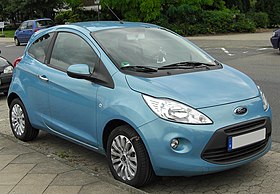 |
|
| Overview | |
| Production | July 18, 2008 – May 20, 2016 |
| Assembly | Tychy, Poland (Fiat Poland) |
| Body and chassis | |
| Body style | 3-door hatchback |
| Platform | Fiat Mini platform |
| Related | Fiat 500 Fiat Panda Lancia Ypsilon |
| Powertrain | |
| Engine | 1.2 L Duratec (FIRE) I4 1.3 L Duratorq (MultiJet) I4 |
| Transmission | 5-speed manual |
| Dimensions | |
| Wheelbase | 2,301 mm (90.6 in) |
| Length | 3,620 mm (142.5 in) |
| Width | 1,658 mm (65.3 in) |
| Height | 1,505 mm (59.3 in) |
| Curb weight | 870 kg (1,920 lb) |

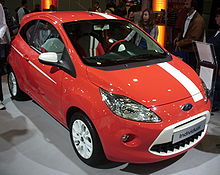
In 2008, the European Ka was replaced with a model developed and produced for Ford by Fiat S.p.A in conjunction with Fiat's own 500 vehicle. The car is built in Fiat's Tychy, Poland, factory alongside the Fiat 500, Fiat Panda and Lancia Ypsilon.
Despite the wholly different architecture underneath, the new Ka maintains the curved styling features of the original, while bringing the look in line with Ford's Kinetic Design philosophy. It retains the wheel-at-each-corner stance of the previous model. Ford promises a cabin featuring 'expressive colours'. This mostly refers to the multichoice interior styling that is provided for the second time in Ford, right after the success of the Fiesta's interior design. In addition, the interior can be equipped with accessories such as a Bluetooth phone connection, wireless voice control, a USB port, a CD Radio, MP3, an AUX connector, steering wheel audio controls and a speaker system consisting of six speakers, a subwoofer and an amplifier.
The new Ka comes with a choice of two engines, a 1.2-litre petrol with 69 PS (51 kW) of power and 102 N·m (75 lbf·ft) of torque and a 1.3-litre TDCi diesel engine with 75 PS (55 kW; 74 hp) of power and 145 N·m (107 lb·ft) of torque. Both engines come with sub-120 g/km CO2 emissions (119 for the petrol and 112 for the diesel). Both engines are supplied from Fiat.
The main mechanical differentiator between the new Ka and its Fiat sibling is that the Ford has better shock absorption than the Fiat 500. Fitting a rear anti-roll bar enabled 30 percent softer springs and accordingly retuned dampers to improve ride performance over uneven road surfaces. Some of these improvements were subsequently adopted on Fiat 500 Abarth and Fiat 500C models. Changes were also made to the 500's steering geometry for the Ka, although as the new Ka uses an electrically assisted steering system, it lacks the communication of its predecessor's hydraulically assisted steering. However, the electric steering system does make the steering much lighter and more energy efficient than its predecessor.
The new Ka has an overall Euro NCAP safety rating of 4 stars, with standard driver and passenger single-stage front airbags, ABS, immobiliser, hazard warning lights and remote central locking (except Studio version in UK). In addition, there are front side airbags and curtain airbags and ESP (Electronic Stability Program) with HBA (Hydraulic Brake Assist) and HLA (Hill Launch Assist) that come at an extra cost.
The new Ka made its debut in the 22nd James Bond film Quantum of Solace and was unveiled in October 2008's Paris Motor Show.
In 2008, there was some speculation that the Ka might be introduced to the North American market. It has since been confirmed however that Ford consider the Ka too small for American tastes and will not be introducing the vehicle to this market.
Ka Individual
There are also three "Ford Individual packs" with special characteristics each (in both the interior and exterior design), called Tattoo, Grand Prix and Digital. Tattoo was replaced in 2011 by Metal. All Individual models are based on the Zetec.









